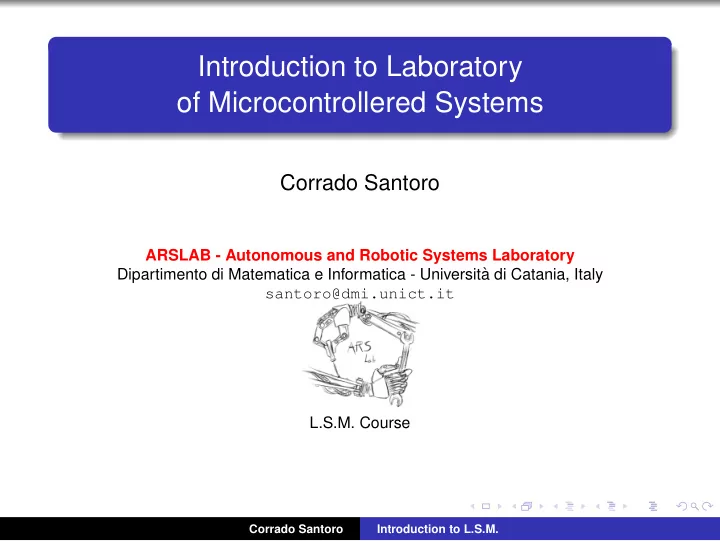

Introduction to Laboratory of Microcontrollered Systems Corrado Santoro ARSLAB - Autonomous and Robotic Systems Laboratory Dipartimento di Matematica e Informatica - Universit` a di Catania, Italy santoro@dmi.unict.it L.S.M. Course Corrado Santoro Introduction to L.S.M.
What is a “Microcontroller”? A Microcontroller (MCU) is an integrated circuit including all parts of complete computer. In includes: CPU Built-in oscillator for clock source Flash memory (in the order of KBytes/MBytes), to hold the program (acting as a ROM) RAM , in the order of KBytes/MBytes Several I/O peripherals for both generic and specific purposes In its PINs, a microcontroller does not provides the BUS (as in normal CPUs) but the I/O peripherals . Corrado Santoro Introduction to L.S.M.
What is a “Microcontroller”? Corrado Santoro Introduction to L.S.M.
What are the typical peripherals? Digital (1-bit) lines Analog lines Analog-to-Digital (ADC) Digital-to-Analog (DAC) Timers Special digital lines (Pulse-Width-Modulation); Communication interfaces for other devices and/or sensors/actuators: USB UART (serial port) SPI (Serial Peripheral Interface) I2C (I-square-C) CAN (Controller Area Network) Ethernet ... Corrado Santoro Introduction to L.S.M.
Where are microcontrollers employed? Special-purpose applications/equipments, such as: Measurement equipments; Cars (i.e. automotive industry, engine control, driver assistance); Household Appliances (TV sets, set-top-boxes, DVD, washing machines, microwave ovens, etc.); Previous-generation cellphones and smartphones; Industrial automation, robotics; Domotics, Internet-of-Things; ... Corrado Santoro Introduction to L.S.M.
How are microcontrollers programmed? Generally, they run the software in bare metal , i.e. without an operating system. In some cases, they host a very small operating system (e.g. FreeRTOS ) able to offer minimum functionalities: a simple driver layer, no MMU, cooperative or preemptive scheduling When the system is programmed in bare metal, the developer has to take care also of programming I/O peripherals Corrado Santoro Introduction to L.S.M.
Typical MCU design pattern ✞ #include "..." /* global variables */ int main() { /* initialization of peripherals */ /* infinite loop */ for (;;) { /* (wait events) */ /* read inputs */ /* process data */ /* write outputs */ } } /* Interrupt Handlers for peripherals */ void xxx_IRQHandler(void) { ... } ✝ ✆ ✡ Corrado Santoro Introduction to L.S.M.
Microcontrollers: manufacturers and families There are many manufacturers of microcontrollers: Microchip Atmel Freescale STMicroelectronics Intel ... A specific microcontroller (the specific chip) is identified by: The core , that is the CPU : 8-bit, 16-bit, 32-bit, etc. The core usually denotes also the family The amount of flash memory and RAM The peripherals which are included in the chip Corrado Santoro Introduction to L.S.M.
The MCU we will use! We will use a MCU of the STM32Fx family by STMicroelectronics. 32-bit ARM-Cortex CPU CPU clock from 80 to 240 MHz Flash memory from 512K to 2M RAM from 512K to 2M Several peripherals (digital, ADC, timers, SPI, I 2 C, CAN, USB, Ethernet) STM32 provides a series of evaluation boards ( Discovery or Corrado Santoro Introduction to L.S.M.
How can I use/program a MCU? Using MCU implies to use its peripherals Thus, we must learn how to program in C the MCU peripherals A certain region of the system memory is reserved for peripherals In this region, each memory location has a specific meaning These memory locations are called Special Function Registers (SFRs) Writing a data into a SFR implies to program the behaviour of a specific peripheral Corrado Santoro Introduction to L.S.M.
How can I access SFR? Using C pointers!! But ... The “Cortex Microcontroller Software Interface Standard” (CMSIS) STM32 libraries export a global variable for each SFR. Therefore, a SFR can be accessed, in C program, by using the relevant variable directly. Corrado Santoro Introduction to L.S.M.
The “stm32 unict lib” Library At first, we do not use SFR directly Access to hardware will be “mediated” by a library written ad-hoc for the LSM course Corrado Santoro Introduction to L.S.M.
Tools for the STM32 microcontroller OpenSTM32 IDE (Editor+Compiler): http://www.openstm32.org A terminal emulator program, such as: minicom or cutecom , for Linux; picocomlap1 for Linux (see LSM web page); ZOC Terminal , for Win and MacOS. TeraTerm , for Win. The “Data Sheet” of the MCU STM32F401RE : http://www.st.com/ The STM32F4Cube Libraries (including the CMSIS): http://www.st.com/en/embedded-software/ stm32cubef4.html The STM32-UNICT-LIB Libraries: http: //www.dmi.unict.it/˜santoro/index.php?p=13 Corrado Santoro Introduction to L.S.M.
Resources for the LSM Course Course Web Page http://www.dmi.unict.it/˜santoro/index.php?p=13 The “Web”! Corrado Santoro Introduction to L.S.M.
LSM Program The digital I/O port of an MCU Elements of circuit analysis; basics of digital circuits Interrupt Management and programming Programming models in MCU environments Managing time in MCUs: how to program and use timers The Analog-to-Digital Converter (ADC) Case-Studies Special signal generation: PWM How to drive a servo-motor How to drive a DC motor How to interface digital and analog sensors How to interface I 2 C/SPI sensors Corrado Santoro Introduction to L.S.M.
Requirements Knowledge: Computer Architectures C language Operating Systems Software Engineering Skills: Programming! English Corrado Santoro Introduction to L.S.M.
Exams! A test which several questions (6–10) with both open answers and multiple choices A practical exam with a program to be developed onto a MCU board Corrado Santoro Introduction to L.S.M.
Other initiatives Collaboration with STMicroelectronics Internship and Thesis Projects at STM Labs Talents in Action! Develop and present your own project! (July-September) UNICT-TEAM: The Robotic Student Team of the Unverisity of Catania Eurobot Competition , May 2020 (project start now, volunteers wanted!) MBZIRC 2020 , Feb 2020 (skilled volunteers are welcome) Corrado Santoro Introduction to L.S.M.
Introduction to Laboratory of Microcontrollered Systems Corrado Santoro ARSLAB - Autonomous and Robotic Systems Laboratory Dipartimento di Matematica e Informatica - Universit` a di Catania, Italy santoro@dmi.unict.it L.S.M. Course Corrado Santoro Introduction to L.S.M.
Recommend
More recommend